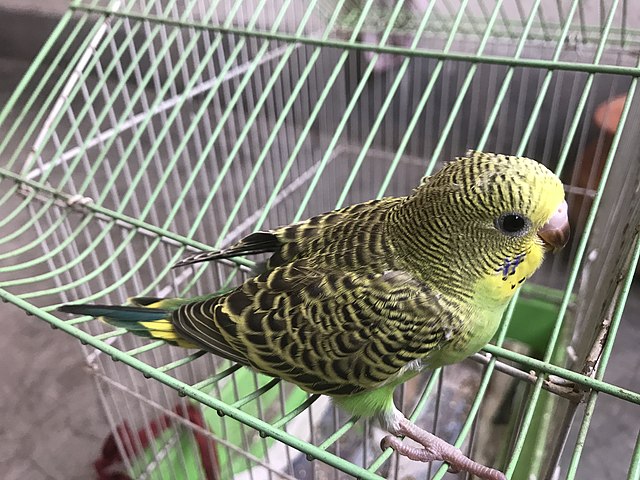Parakeets are active, playful little birds and do best in as large a cage as you can afford. Most commercial budgie cages are much too small, and the larger ones tend to be fairly expensive. I would say the minimum for a single bird or perhaps a pair if they got *lots* of time out, would be about 18″ x 18″ 24″. Stock it with lots of toys; most budgies are very playful birds!
Most parrots spend the majority of their lives inside their cage, therefore, it must be a happy place for a parakeet to be, and one that assures you that your bird is safe in your absence. Think of it as your bird’s bedroom. There should be many things to do to keep it entertained and mentally occupied while you are away and it should offer your bird security and privacy.

Many people feel that the cage should be accessorized in a way that makes things easy and comfortable for their bird. We disagree. We believe that, since your bird spends so much time in a cage, it should be set up in a way that promotes activity and exercise.
Life in the wild requires a lot of climbing, reaching, and flying. We encourage you to provide the same opportunities in your home by purchasing the largest cage you can that is appropriate for a parakeet so that there is room for flight within. It keeps their muscles well-toned and allows them to do what they were designed to do.
Place toys and foragers in an out-of-the-way place that is awkward for them to reach instead of near perches that make it convenient. One of the biggest health concerns for birds according to vets is obesity and to avoid that your bird needs activity.
A cage for a parakeet should be NO LESS than 18″ x 18″ x 24″. Consider that the bare minimum. Bar spacing should be no larger than 1/2″ apart. You would be surprised how many injuries occur when a parrot sticks its head through bars that are spaced too widely apart and find itself stuck there.
Perches
Your parakeet will spend its entire life on its feet, so perch selection is important. Place a variety of perches in the cage all with different sizes, shapes, and textures to promote good foot health. The just-right perch is the one that the foot wraps 3/4 of the way around. This might be the one your parakeet chooses to sleep on at night. Perches should ideally be natural branches; throw out those dowel perches and sandpaper coverings! They can cause foot problems. If you really must have dowel perches, buy ones in a variety of diameters.
Select toys that vary in texture and color and are appropriate for a parakeet. While large parrots can sometimes utilize smaller toys, it generally isn’t safe to give large toys to a small bird. There are many places that can trap wings, feet, and heads. Parakeets seem to most enjoy toys that are made of raffia and other natural shreddable materials and brightly colored plastic toys.
Be sure to change the cage bottom papers several times a week and keep the interior of the cage and perches free from dirt and old food that will collect bacteria.
